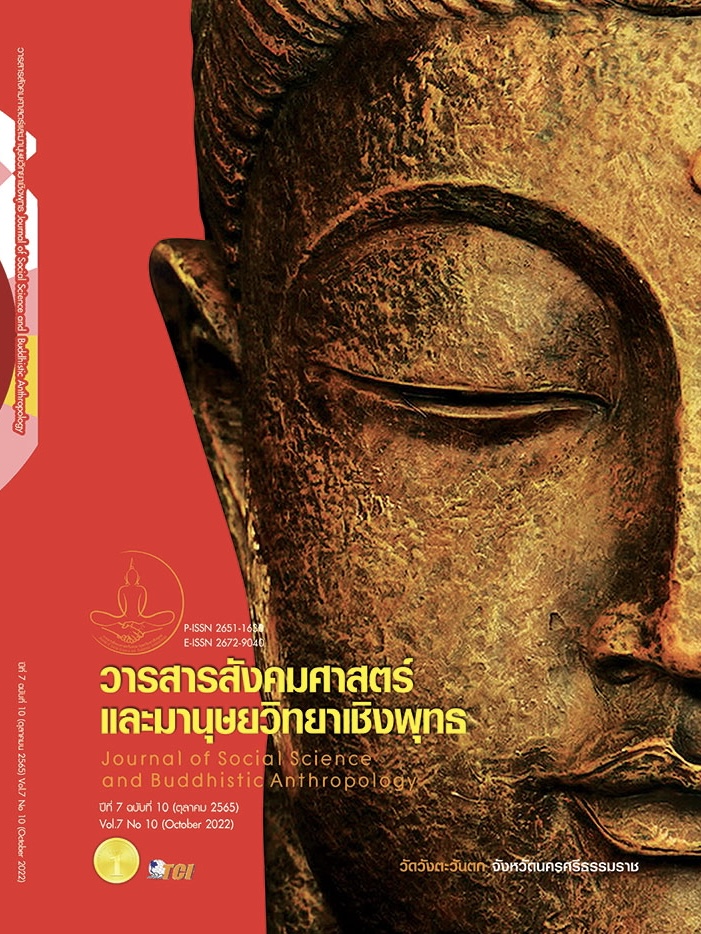COMMUNICATION MANAGEMENT GUIDELINES AND THE IMPACT OF ESPORTS IN THAI SOCIETY
Keywords:
Communication, Impact, EsportsAbstract
The Objectives of this research article were to 1) communication in game and esports online community; 2) impact of esports in Thai society and 3) communication management guidelines and impact of esports in Thai society. Qualitatively, the research is conducted by 1) Document Analysis 2) Participant Observation 3) In-depth Interview of 16 people who were esports athletes, esports player, scholar and professional, which was purposive sampling. The research outcomes are 1) Communication in esport games and online gaming communities is Two Way Communication. Through the game systems, communication messages are interacted through text boxes and vocal conversations via speakers and microphones. The purposes of communication are delivered based on two positions. Firstly, as senders, game casters and esports athletes communicate to cast the games. Secondly, as receivers, gamers watch and follow the game casting. In gaming context, various communicative styles are created, depending on different personalities of each game casters. Noticeably, abusive languages and contents are detected, especially among children and adolescents. According to the interview, esports contain both positive and negative impacts. Regarding the upside, it is a recreational activity which emotionally provides entertainment and relaxation. However, the downside concerns both physical and mental healths such as eyesight problems, muscle pain, sedentary behavior, and game addiction. 2) The researcher proposes ESPORTS Model as guidelines for communication management and the impact of esports in Thai society. They are E: Ecosystem of Esports, S: Social Media and Game Communication, P: Protection of Children and Adolescents, O: Opportunity to Create New Careers, R: Rules, Regulations and Responsibility, T: Training to Create Smart Players and Business Operators and S: Soft Power Esports Industry.
References
กาญจนา แก้วเทพ. (2554). สื่อสารมวลชน: ทฤษฎีและแนวทางการศึกษา. กรุงเทพมหานคร: ภาพพิมพ์.
เจตน์จันทร์ เกิดสุข และลัทธสิทธิ์ ทวีสุข. (2562). แรงจูงใจของผู้ชมอีสปอร์ตที่ส่งผลต่อการติดเกม. วารสารนิเทศสยามปริทรรศน์, 18(2), 13-152.
ชลลดา บุญโท. (2554). พฤติกรรมการเล่นเกมออนไลน์ของนักศึกษามหาวิทยาลัยเทคโนโลยีราชมงคลธัญบุรีและผลกระทบจากการเล่นเกมออนไลน์. ใน วิทยานิพนธ์บริหารธุรกิจมหาบัณฑิต สาขาวิชาระบบสารสนเทศ. มหาวิทยาลัยเทคโนโลยีราชมงคลธัญบุรี.
ฐานเศรษฐกิจ. (2560). ตลาดเกมออนไลน์ในไทยโตกว่า 32.4 เปอร์เซ็นต์ ผู้เล่นรายใหญ่จากเกาหลีบุกไทย. เรียกใช้เมื่อ 15 กันยายน 2560 จาก https://www.thansettakij.com /business/ 171647
ดิจิทัลเอจ. (2560). อุตสาหกรรมเกมเติบโตเร็ว ผู้ให้บริการเกมของเกาหลี เปิดตัวในไทย. เรียกใช้เมื่อ 15 กันยายน 2560 จาก https://www.digitalagemag.com
ไทยทริบูน. (2560). สถิติเด็กติดเกมพุ่ง 1.5 เท่า อายุต่ำสุดแค่ 5 ขวบ เสี่ยง'สมาธิสั้น-ดื้อต่อต้าน'. เรียกใช้เมื่อ 13 กันยายน 2560 จาก http://thaitribune.org/contents/ detail
ธัญญากร บุญมี. (2560). อัตลักษณ์เสมือนกับการสร้างปฏิสัมพันธ์ทางสังคมบนเครือข่ายสังคมเกมออนไลน์. ใน วิทยานิพนธ์ศิลปศาสตรมหาบัณฑิต สาขาวิชานิเทศศาสตร์และนวัตกรรม. สถาบันพัฒนบริหารศาสตร์.
ธีรภัค คมนา. (2556). การวิเคราะห์รูปแบบเกมออนไลน์ที่มีต่อพฤติกรรมการเรียนรู้ของนักเรียน ระดับชั้นมัธยมศึกษา ปีที่ 1 โรงเรียนธัญรัตน์ จังหวัดปทุมธานี. ใน วิทยานิพนธ์ศึกษาศาสตรมหาบัณฑิต สาขาวิชาเทคโนโลยีและสื่อสารการศึกษา. มหาวิทยาลัยเทคโนโลยีราชมงคลธัญบุรี.
นัทธี พันทวีศักดิ์. (2558). แผนธุรกิจผลิตและจัดจำหน่ายอุปกรณ์อีสปอร์ต (E-Sport). ใน วิทยานิพนธ์บริหารธุรกิจมหาบัณฑิต สาขาวิชาการจัดการสำหรับการเป็นผู้ประกอบการ. มหาวิทยาลัยเทคโนโลยีพระจอมเกล้าธนบุรี.
บีบีซีไทย. (2560). ผู้ใหญ่ก็ติดเกมได้: ตลาดเกมมือถืออาเซียนโตสูงสุดในโลก. เรียกใช้เมื่อ 19 กันยายน 2560 จาก http://www.bbc.com/thai/thailand-40565506
บุหงา ชัยสุวรรณ และพรพรรณ ประจักษ์เนตร. (2560). พฤติกรรมการใช้สื่อใหม่ของวัยรุ่นอายุระหว่าง 10-19 ปี. วารสารการสื่อสารและการจัดการนิด้า, 1(1), 31-57.
พัสกร คงสาคร และคณะ. (2556). รายงานการวิจัย ความสัมพันธ์ระหว่างความวิตกกังวล ทางสังคม . ใน การรับรู้ความสามารถทางคอมพิวเตอร์ การควบคุมตนเอง กับพฤติกรรมการเล่นเกมออนไลน์. จุฬาลงกรณ์มหาวิทยาลัย.
พุฒตาล ปราชญ์ศรีภูมิ. (2561). ปัจจัยที่มีผลต่อความตั้งใจที่จะชมกีฬาอิล็กทรอนิกส์. ใน วิทยานิพนธ์วิทยาศาสตรมหาบัณฑิต สาขาระบบสารสนเทศเพื่อการจัดการ. มหาวิทยาลัยธรรมศาสตร์.
ภาพิมล ไชยวุฒิ. (2558). แรงจูงใจในการสมัครเข้าเป็นนักกีฬาอิเลคโทรนิคส์ (ESports). ใน สารนิพนธ์บริหารธุรกิจมหาบัณฑิต สาขาการจัดการธุรกิจระหว่างประเทศ. มหาวิทยาลัยสยาม.
มาร์เก็ตเธียร์. (2562). เผยปี 61 ผู้ชมอีสปอร์ตไทย 11. ล้านคน เติบโตเร็วสุดในโลก. เรียกใช้เมื่อ 20 สิงหาคม 2562 จาก https://marketeeronline.co/archives/108515
ศัลยาภา นวรัตน์ และ โมไนยพล รณเวช. (2561). ความคาดหวัง การเปิดรับ และความพึงพอใจต่อรายการถ่ายทอดการแข่งขันอีสปอร์ต. วารสารการสื่อสารและการจัดการ นิด้า, 4(2), 46-60.
อภิวรรณ ศิรินันทนา. (2559). การสื่อสารของกลุ่มผู้เล่นเกมออนไลน์ในยุคดิจิทัล. วารสารเทคโนโลยีสื่อสาร มวลชน มทร.พระนคร, 1(1), 56-65.
เอ็มไทยนิวส์. (2560). เจ๋ง! ครูจัดแข่ง ROV ในโรงเรียน หวังส่งเสริมกีฬา ESPORTS. เรียกใช้เมื่อ 15 กันยายน 2560 จาก https://news.mthai.com/social-news/581487. html
Jonasson, K. & Thiborg, J. (2010). Electronic sports and its impact on future sport. Sport in Society, 13(2), 287-299.
Nuangjumnong, T. (2016). Development of Leadership through Esports. In Doctoral’s dissertation. Waseda University.
Petrova, K., & Qu, H. (2007). Playing mobile games: Consumer perceptions. Paper presented at the Proc2nd int. conf. e-Business (ICE-B 2007). Retrieved April 19, 2019, from https://www.academia.edu/1086831/Playing_mobile_ games_ consumer_ perceptions
Wu, M. et al. (2017). Fairness mechanism in multiplayer online battle arena games. The 2016 3rd International Conference on Systems and Informatics (ICSAI 2016). Retrieved April 19, 2019, from https://ieeexplore. ieee.org/document/7810986
Downloads
Published
How to Cite
Issue
Section
License
Copyright (c) 2022 Journal of Social Science and Buddhistic Anthropology

This work is licensed under a Creative Commons Attribution-NonCommercial-NoDerivatives 4.0 International License.








